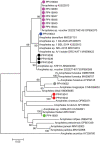Vectorial drivers of malaria transmission in Jabi Tehnan district, Amhara Regional State, Ethiopia
- PMID: 38871839
- PMCID: PMC11176308
- DOI: 10.1038/s41598-024-64436-3
Vectorial drivers of malaria transmission in Jabi Tehnan district, Amhara Regional State, Ethiopia
Abstract
Among the factors affecting the effectiveness of malaria control is poor knowledge of the entomologic drivers of the disease. We investigated anopheline populations as part of a baseline study to implement house screening of windows and doors as a supplementary malaria control tool towards elimination in Jabi Tehnan district, Amhara Regional State of Ethiopia. The samples were surveyed monthly using CDC light traps between June 2020 and May 2021. Mosquito trap density (< 3 mosquitoes/trap) was low, however, with a high overall Plasmodium sporozoite rate (9%; indoor = 4.3%, outdoor = 13.1%) comprising P. falciparum (88.9%) and P. vivax (11.1%). Anopheles gambiae s.l., mostly An. arabiensis, comprised > 80% of total anopheline captures and contributed ~ 42% of Plasmodium-infected mosquitoes. On the other hand, morphologically scored Anopheles funestus s.l., constituting about 6% of anopheline collections, accounted for 50% of sporozoite-infected mosquitoes. Most of the infected An. funestus s.l. specimens (86.7%) were grouped with previously unknown or undescribed Anopheles species previously implicated as a cryptic malaria vector in the western Kenyan highlands, confirming its wider geographic distribution in eastern Africa. Other species with Plasmodium infection included An. longipalpis C, An. theileri, An. demillioni, and An. nili. Cumulatively, 77.8% of the infected mosquitoes occurred outdoors. These results suggest efficient malaria parasite transmission despite the low vector densities, which has implications for effective endpoint indicators to monitor malaria control progress. Additionally, the largely outdoor infection and discovery of previously unknown and cryptic vectors suggest an increased risk of residual malaria transmission and, thus, a constraint on effective malaria prevention and control.
Keywords: Cryptic vectors; Highland areas; Malaria surveillance; Outdoor biting; Residual malaria transmission.
© 2024. The Author(s).
Conflict of interest statement
The authors declare no competing interests.
Figures




Similar articles
-
Feeding habits and malaria parasite infection of Anopheles mosquitoes in selected agroecological areas of Northwestern Ethiopia.Parasit Vectors. 2024 Oct 3;17(1):412. doi: 10.1186/s13071-024-06496-y. Parasit Vectors. 2024. PMID: 39363366 Free PMC article.
-
Higher outdoor mosquito density and Plasmodium infection rates in and around malaria index case households in low transmission settings of Ethiopia: Implications for vector control.Parasit Vectors. 2024 Feb 6;17(1):53. doi: 10.1186/s13071-023-06088-2. Parasit Vectors. 2024. PMID: 38321572 Free PMC article.
-
Species composition, blood meal hosts and Plasmodium infection rates of Anopheles mosquitoes in Ghibe River Basin, southwestern Ethiopia.Parasit Vectors. 2019 May 23;12(1):257. doi: 10.1186/s13071-019-3499-3. Parasit Vectors. 2019. PMID: 31122286 Free PMC article.
-
Systematic review of sporozoite infection rate of Anopheles mosquitoes in Ethiopia, 2001-2021.Parasit Vectors. 2023 Nov 27;16(1):437. doi: 10.1186/s13071-023-06054-y. Parasit Vectors. 2023. PMID: 38008761 Free PMC article. Review.
-
Changes in contributions of different Anopheles vector species to malaria transmission in east and southern Africa from 2000 to 2022.Parasit Vectors. 2023 Nov 7;16(1):408. doi: 10.1186/s13071-023-06019-1. Parasit Vectors. 2023. PMID: 37936155 Free PMC article. Review.
Cited by
-
Feeding habits and malaria parasite infection of Anopheles mosquitoes in selected agroecological areas of Northwestern Ethiopia.Parasit Vectors. 2024 Oct 3;17(1):412. doi: 10.1186/s13071-024-06496-y. Parasit Vectors. 2024. PMID: 39363366 Free PMC article.
-
A randomized controlled trial combining house screening and insecticide-treated nets reduces malaria transmission in northwestern Ethiopia.Sci Rep. 2025 May 21;15(1):17709. doi: 10.1038/s41598-025-02943-7. Sci Rep. 2025. PMID: 40399511 Free PMC article. Clinical Trial.
-
Blood feeding patterns of malaria mosquitoes collected using pit shelters and clay pots in the West Gojjam zone of Ethiopia.Malar J. 2025 May 28;24(1):169. doi: 10.1186/s12936-025-05408-4. Malar J. 2025. PMID: 40437536 Free PMC article.
References
-
- World Malaria Report 2021. Geneva: World Health Organization; 2021. Licence: CC BY-NC-SA 3.0 IGO.
-
- World malaria report 2023. Geneva: World Health Organization; 2023. Licence: CC BY-NC-SA 3.0 IGO.
MeSH terms
Grants and funding
LinkOut - more resources
Full Text Sources

